Now & New
- Explore
Daifuku and Frozen Landscapes: The Rarest Side of Shukkeien
Hiroshima’s Shukkeien—like most other landscape gardens in Japan—is beautiful year-round, with stunning scenery to be beheld in each season. Even within specific seasons, such as spring, different sections of Shukkeien become a focus spot based on the seasonal flower varieties. Case in point, the month of April is abundant with hanami-worthy species like cherry blossoms and peonies, among others, whose peaks occur at different times. Detailed information regarding what to see and where to see it can be found in the brochure, which features a picture of the same view of Shukkeien in each of the four seasons: it looks pink in spring, green in summer, orange in autumn, and white in winter. Out of all the seasons, the winter vista wherein the vegetation is blanketed in snow is probably the hardest one to capture in camera simply for how seldom it snows that much in the heart of Hiroshima City.
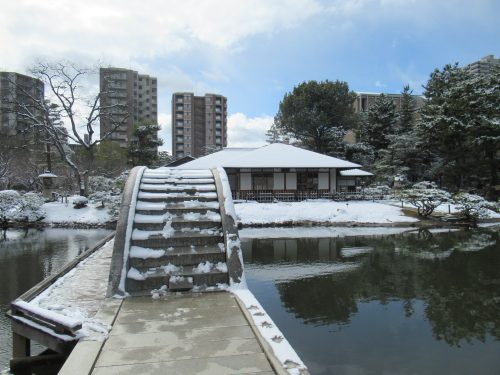
Winter in Hiroshima City has always been relatively mild in comparison to the small towns in the northerly Geihoku or Bihoku areas of the prefecture. Being close to the sea factors into downtown Hiroshima’s higher temperatures, and thus the lower frequency of snow falling, let alone accumulating. Even within Hiroshima City, mountainous, inland parts of the city—around the neighborhood of Ushita and northward from there—are more likely to freeze over than the urbanized Naka Ward (the city center) or Minami Ward (basically between Hiroshima Station and Ujina Port). This is why some of Hiroshima’s principal tourist sites seldom get a white blanket in the colder months, even when temperatures drop below zero. In fact, prior to this winter, the last time I remember downtown Hiroshima becoming a winter wonderland was in January of 2017. Back then, I took a walk to Peace Park to marvel at the snow globe that the Atomic Bomb Dome had become, and while the view there was stunning, for the longest time, I kicked myself for not checking out Shukkeien on the same day. However, with winter temperatures being as atypical as they have been for the past few years, I knew it was a matter of years before downtown would turn white yet again.
Repeat Christmas Miracle
On Friday, December 23rd, 2022, the city center of Hiroshima experienced heavy snowfall, creating a white carpet on the streets and greenery. As this was the day that I was preparing for my winter vacation overseas, I couldn’t enjoy the snowy city center for long, but even after I left for my trip, I heard that snow continued to pile up in Hiroshima on Christmas Eve as well. I had mixed feelings about that weekend: I was happy to see central Hiroshima snow that much again after what felt like forever, but also resentful that it happened when I couldn’t take time out to savor a frosty Shukkeien. Little did I know then that another chance would rear its head on Wednesday, January 25th, 2023, when I was not only in town, but had the whole day off to boot!

That morning was particularly cold, to the point where most people would shut themselves in for an additional 24 hours. I wasn’t entirely sure how the weather was outside since the view out my window is just the adjacent building, but after craning my neck out from the balcony, I discovered that the Christmas miracle from last month came back for a visit! Naturally, my initial instinct was to make the journey to Shukkeien, and to guarantee I would see snow in the garden, I called them just to check. The lady on the phone claimed that lots of snow was still on the rooftops of the buildings and some was lingering on the trees, but all of it was melting fast as the sun continued to rise. Upon hearing about even a tiny sliver of hope, I got out of bed, bundled up, and hurriedly penguin-walked all the way up to Shukkeien.

When I entered the garden premises and bought my ticket, I noticed the prevalent snowfall everywhere, which was a lot more than what the lady on the phone made it sound like. Parts of the ground where humans didn’t traverse were completely concealed by white powder, and the cycads that greet visitors in every other season were covered in these straw jackets to prevent them from freezing to death. At this point in the late morning, most of the vegetation was still covered in snow, but the most beautiful view was that of the central pond, where carp subtly swam underneath and the reflection of the landscape above seemingly doubled the amount of visible snow.

I took my sweet time circumnavigating all of Shukkeien, and throughout my visit, there was this couple in a kimono and hakama doing a photoshoot everywhere in the garden. At one point, I saw them standing next to the Seifukan teahouse from the opposite side of the pond, and I must say that they could not have picked a better day to visit Shukkeien. I definitely was not unique in pouncing on this chance to see a snow-covered landscape garden, for the more time passed, the more visitors started to enter and admire the increasingly decreasing frost.
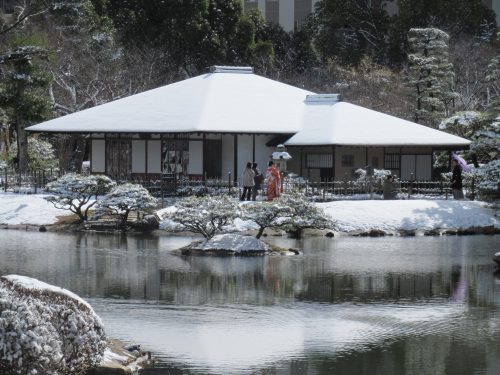
The snow has effects other than just looking pretty, though. Besides the rooftops and trees being concealed, some of the pathways through the garden (i.e., the narrow bridges crossing over the water) accumulated enough snow to be too dangerous to walk on. Due to the risk of slipping into the pond and dying of hypothermia, Shukkeien closed some of the paths that went over the pond, but as a result, said unhindered paths remained pristine and retained their frozen beauty.
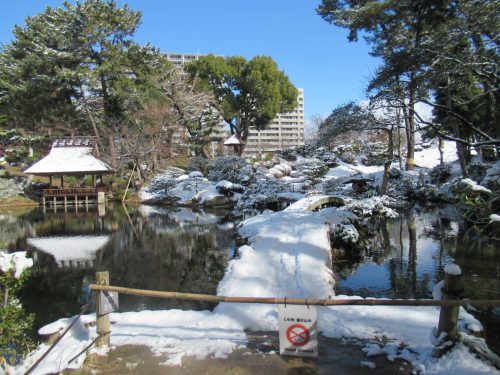
Moment of Joy: Brightness Above and Below

As noon approached, the clouds opened up to make way for the sun, which started melting the snow at an even faster pace. I knew I had to hurry from the moment I entered Shukkeien, but when the sky cleared up, I knew the race against time was really on. Having the radiant sun above and the glistening snow reflecting all that light made every photo all the more stunning, especially when taking pictures from atop the Geikiho, the highest point in the entire garden. I scoured every square meter of this urban landscape garden to magical photo opportunities until my grumbling tummy told me to switch goals.
Winter Picnic
There was no better place to have lunch that day than at Sensuitei, the restaurant and gift shop with plentiful outdoor seating in the midst of the snowscape. At humble eateries like this, one can never go wrong with an udon set meal, but given the time of year, I made sure to go for a mochi topping. The mochi gave off Japanese New Year vibes because people have them in ozoni, a traditional New Year’s soup, and although quite some time had passed since we rang in the new year, I can’t resist having mochi at any point in January. That bowl of udon came with a cup of hot tea and one rice ball with a plum filling, the plum being the most popular flower that blooms in winter.
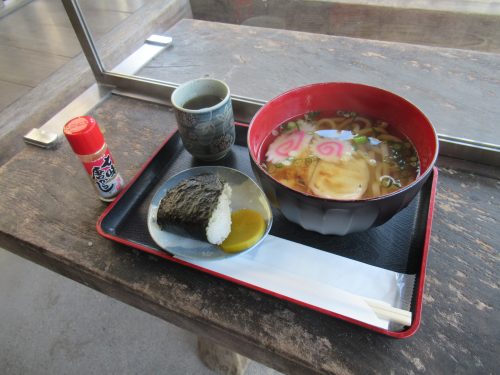
After finishing my piping hot meal and bolstered by resistance to the elements, I took one final stroll about the garden before going home. In spite of the sunlight being at its strongest during lunch, the snow cover on the roof of Seifutei had yet to vanish. Before entering Shukkeien today, I had read on an electronic signboard outside that a tea ceremony was to be held inside Seifukan on Sunday, the 29th of January. There probably wouldn’t be any more snow by then, but I made a promise to revisit Shukkeien to see the inside of that teahouse, something I had yet to do.
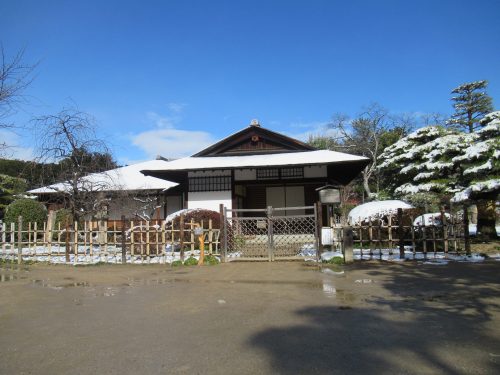
More Winter Sights
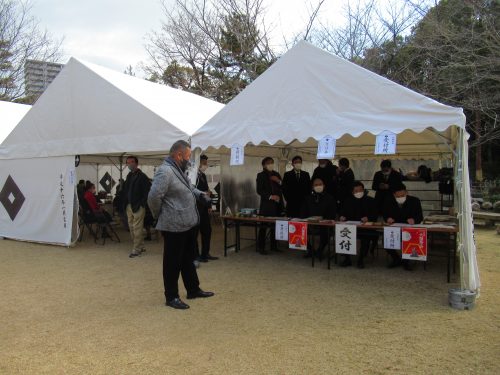
Four days later, I hit up Shukkeien as I promised myself to take part in what would be my first tea ceremony at Seifukan. I tried getting there as early as I could and arrived at ten-something in the morning, but even that was a bit late as I realized how many others had beaten me to the punch. When I approached the registration counter to sign up for the next tea ceremony, I was told that the first two were fully booked and that the next available one would start at 11:40 a.m. I reserved my spot for that one, paid, got my ticket, and was told to return and wait in line five minutes before the start of the ceremony at the latest.
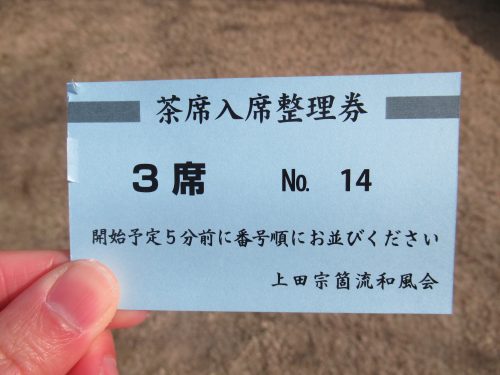
“No biggie,” I thought to myself, because as I had already paid for admission into Shukkeien in order to register for the tea ceremony, I might as well leisurely wander about the garden again and admire the same stuff not covered in snow. The first section I went for was the plum grove, which had no flowers four days ago, and I was pleased to find out that some of the trees were starting to flower. Come winter, this part of Shukkeien is what everybody comes to see first, and once February rolls around, the trees in this grove would become a lot more colorful.
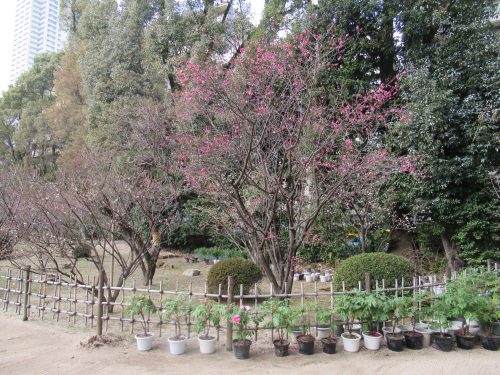
I took my photos of the fresh plum blossoms, but still had ample time to kill before I had to head back. As I walked over every path available—even the ones I was denied access to when Shukkeien froze over—I passed by Seifukan a couple times, hoping to catch glimpses of the tea ceremony when peeking through the window. All I saw were the backs of participants sitting in their chairs, which was boring, so I tiptoed around the building and found some gigantic pots filled with water. I knew it was freezing just a few days ago, but with all the snow gone, the water inside must all be liquid by now, right? Turns out I was mistaken, because the surface of the water in these pots was still frozen, solidified to the point where I could turn these floating ice discs with one finger like some polar disc jockey.
Daifuku Tea Time
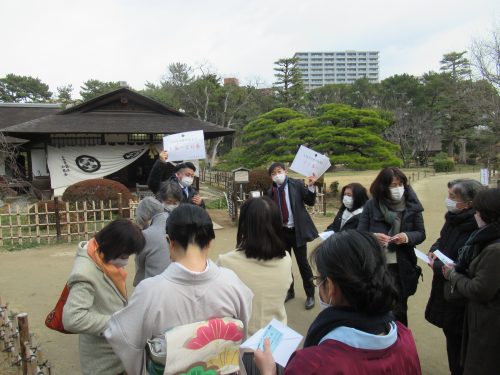
Finally, it came time for me to return to the front entrance of Seifukan and stand in line. We were instructed to make two lines and get in order according to the number on our tickets. Despite being number 14 myself, I found myself near the front of the line, perhaps due to some guests running late. The second thing I noticed was that I had considerably underdressed: most other participants were wearing business casual or better, with some ladies in kimono too. If it’s any silver lining, because photography is forbidden inside Seifukan, at least no one would have any pictures of my underdressed self, so when the staff gave the signal, I entered the teahouse with my head held high.
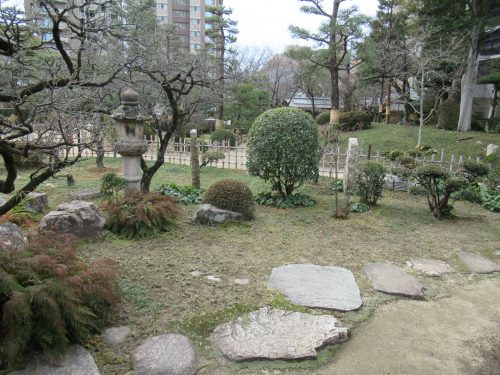
Unfortunately, no photography means I am writing this account based purely on my memory of the ceremony, and the only picture I could take was this view of the garden from inside the house. Those in charge of the tea ceremony were from the Ueda Soko-ryu, a school of thought within the field of tea ceremony with origins in Hiroshima, and they all know their stuff really well. The only thing that could’ve made this tea ceremony even more authentic is if we all sat in seiza (kneeling directly on the floor with our buttocks squishing our feet), but because people’s legs would often fall asleep, nowadays everyone gets a chair.
Since it was a “Daifuku Tea Ceremony,” the first item served to us was a daifuku, a Japanese dessert that consists of a mochi filled with sweet, red bean paste. Daifuku is an idea snack to consume in January because the Japanese word “daifuku (大福)” means “great fortune,” which is what everyone wishes everybody else for the New Year. After we finished eating our daifuku, we were served a cup of matcha, which had a black bean and a pickled plum at the bottom of the cup. These foods are also auspicious and associated with the New Year, and make great surprise snacks. The wooden board we ate the daifuku off of was engraved with a “Year of the Rabbit” design, and we were allowed to take it home as a souvenir after the conclusion of the ceremony.
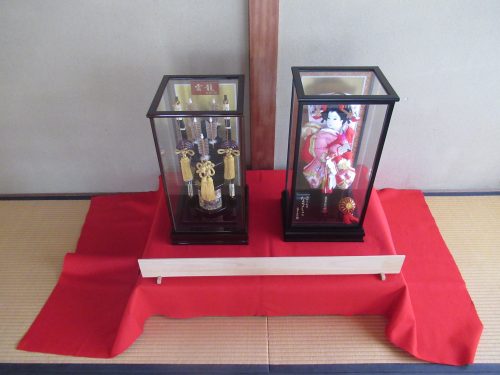
When the tea ceremony ended, the tea masters left their instruments where they were so that we could examine them up close. The container used to mix the tea was engraved with elegant and auspicious symbols like cranes and flowers, as was the stone vessel used to heat the water for the tea. On our way out, we could see a miniature display of Hina dolls in glass cases, something more typical of March than of January. As this was the only other thing I was allowed to photograph, I took forever and a day trying to take the perfect photo of it without anybody else getting in the way, and ended up being the last person to leave Seifukan before they could start the next tea ceremony.
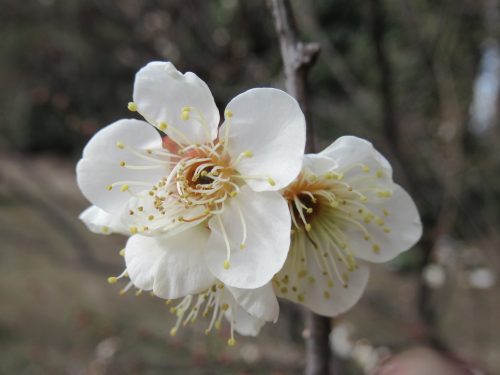
Indeed, there is always something enriching to be encountered at Shukkeien, even in the dead of winter when most plants are seemingly devoid of life. If you aren’t lucky enough to see the garden covered in snow, try to make it for one of the tea ceremonies, always held on a Sunday: there’s a daifuku tea ceremony in late January and a plum blossom viewing tea ceremony in mid-February. Failing that, simply time your visit with peak plum season and you can have your own tea party in the picnic area adjacent to the plum grove. That said, I consider being able to see snow, plum blossoms, and the inside of Seifukan all in the same week to be a major victory deepening my understanding of Hiroshima’s beloved landscape garden in what is usually deemed the least attractive of the four seasons. The thing is, however, that nature never ceases to dazzle with its cycle, so unless you visit a garden at least four times (at least once for every season), you’ll never see the whole picture. Come rain or snow, I hope all visitors to Hiroshima will consider repeat visits to experience our nature in every season and see how our living city breathes life into its residents every day of the year.
Written by the Joy in Hiroshima Team
